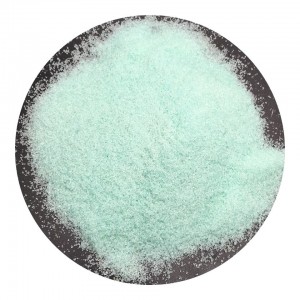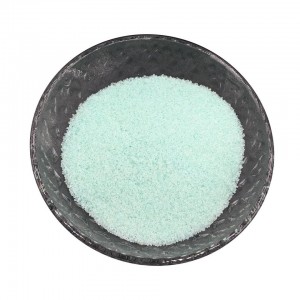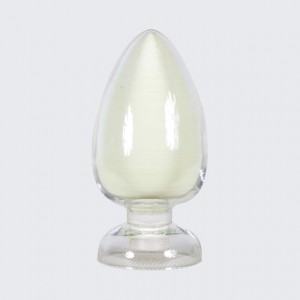Ferrous Sulfate Heptahydrate
Ferrous Sulfate Heptahydrate
Product Description
Ferrous sulfate heptahydrate, also known as green vitriol, has a blue-green sandy crystal appearance, it is light green when dissolved in aqueous solution. Ferrous sulfate heptahydrate itself is unstable and easy to be weathered and oxidized. At present, the simple and direct method of utilization is to make it lose 6 crystal water by air drying,acuum dryin.
As a fertiliser or soil amendment, it is useful in helping green up turf before major events.
Also useful in burning off some weed varieties in turf.
Helps overcome leaf tissue deficiencies and eliminate yellowing of leaves.
Like all Sulphate fertiliser forms it will aid in reducing pH over time in highly alkaline soils where a program using Sulphates is being used to acidify soil and bring pH down within the ideal range.
|
item |
content |
|
FeSO4.7H2O % |
≥ 85.0 |
|
TiO2 % |
≤ 1.0 |
|
H2SO4% |
≤ 2.0 |
|
Pb% |
≤ 0.003 |
|
As% |
≤ 0.001 |
* Standard samples are determined by the customer in consultation with the supplier
Ferrous sulfate heptahydrate is the high water content in ferrous sulfate hydrate, and ferrous sulfate monohydrate is the product of partial dehydration of ferrous sulfate heptahydrate,. It can be summarized in one sentence: ferrous sulfate heptahydrate is the newly made ferrous sulfate with high moisture content, and ferrous sulfate monohydrate is the product of secondary processing of ferrous sulfate heptahydrate with low moisture and high content, which is used for feed and various industrial sewage.
Application
1.Water Treatment
Introduction to water-treated ferrous sulfate:
The common ferrous sulfate used in the water treatment is the ferrous sulfate containing seven crystalline water, also known as the ferrous sulfate heptahydrate.
Ferric sulfate has good flocculation effect, large coagulation particles, fast settlement, good color removal effect, low cost, and can be used in the treatment of a variety of wastewater.
Ferrite sulfate is widely used in water treatment. It can be subdivided as follows:

As a coagulant: Ferrite sulfate coagulant agent is widely used in the treatment of printing and dyeing wastewater, the key to printing and dyeing wastewater treatment is decolorization and COD removal, and coagulation decolorization is an indispensable link, sulfuric acid has a very stable printing and dyeing wastewater decolorization treatment removal effect. Water-treated ferrous sulfate is easily oxidized to a yellow or rust color in wet air. Soluve in water, the general concentration of the prepared solution is about 5% -10%, the product content is 80% -95%. As a coagulant, the coagulation particles are large, good hydrophobic, fast settlement, very good color removal effect, and low cost of treatment agents.
As a reducing agent:Ferric sulfate is a strong reducing agent and has an outstanding effect in treating chromium-containing wastewater. The hexavalent chromium in the chromium-containing wastewater of the electroplating plant can be reduced into trivalent chromium, which has a low price and does not produce toxic and carcinogenic irritant gases.
As flocculant:Ferrous sulfate is used as a flocculant with fast sedimentation rate, small and dense overall sludge volume, and good color removal effect. It is very suitable for subsequent sewage with biochemical treatment system, and is a common flocculant for printing and dyeing wastewater and textile wastewater treatment. It can replace polyaluminum chloride, polyferric sulfate, aluminum sulfate, etc. as more economical and practical flocculants, and can remove a large number of suspended solids in sewage, and remove part of cod and decolorization.
As a precipitant:Ferrous sulfate can form sediment with sulfide and hydrate to remove sulfide and phosphate, which has obvious effect on the treatment of sulfur-containing wastewater in printing and dyeing plants.
As a decolorization agent:Ferrous sulfate not only has the characteristics of flocculation and sedimentation, but also has the effect of decolorization, and can also remove some heavy metal ions. Especially, ferrous sulfate has obvious effects on decolorization and COD removal of printing and dyeing wastewater, and ferrite co-precipitation of electroplating wastewater.
As a bionutrient:Ferric sulfate is mainly used as iron nutrition for microorganisms in the biochemical system to improve the activity of microorganisms in the system, so as to ensure and improve the efficiency and stability of the system.
Be used to treat chromium-containing wastewater:Chromic acid is sometimes used in the process of electroplating and leather production, which results in the residual heavy metal ions in the wastewater containing chromium metal ions. Chromium ion compounds are toxic and exist in the wastewater in the form of trivalent chromium, hexavalent chromium or metallic chromium. The main treatment method of hexavalent chromium can be chemical reduction precipitation. Ferrous sulfate has a very strong reducibility to hexavalent chromium and can reduce chromium ion to produce chromium hydroxide precipitation.
Treatment of cyanide-containing wastewater:Cyanide-containing wastewater comes from a wide range of sources (such as electroplating wastewater). A very small amount of cyanide will cause people and livestock to be poisoned and die in a very short time, and will also cause crop production reduction. There are many methods to treat cyanide-containing wastewater, such as acidification recovery, membrane separation, chemical complexation, extraction, natural degradation, chemical oxidation, etc. In addition to adding ferrous sulfate, the chemical complexation method also needs to add a little auxiliary agent, usually polyacrylamide. In addition to removing cyanide in sewage, it can also remove COD and some heavy metals in water.
Fenton Reagent:Fenton Fenton reagent Fenton Fenton reagent has very high oxidation capacity. Fenton reagent method is a kind of advanced treatment process combining ferrous sulfate and hydrogen peroxide. It uses the strong oxidation-reduction of ferrous sulfate and hydrogen peroxide to generate hydroxyl radicals with strong oxidizing reaction, and forms free radicals with refractory organic substances. It is widely used in chemical wastewater, and is the most widely used in electroplating wastewater treatment. Fenton reagent mainly consists of ferrous sulfate and hydrogen peroxide, which are often used separately in wastewater treatment. The combination technology of the two is advanced strong oxidation technology. This is because the mixed solution of hydrogen peroxide (H2O2) and divalent iron ion Fe oxidizes large molecules into small molecules and small molecules into carbon dioxide and water. At the same time, FeSO4 can be oxidized into trivalent iron ions, which has a certain flocculation effect. The trivalent iron ions become ferric hydroxide, which has a certain net capture effect, so as to achieve the purpose of water treatment. It is widely used in chemical wastewater, and most widely used in electroplating wastewater treatment.
|
wastewater of chemical industry |
precipitant |
Leather wastewater |
Printing and dyeing wastewater |
|
flocculation |
decolor |
The emulsified wastewater |
coagulate |
usage method:
1. Fill the dissolving tank with normal temperature tap water and start the agitator; Then add ferrous sulfate, the ratio of ferrous sulfate to tap water is 1:5-2:5 (weight ratio), mix and stir for 1.5-2 hours until it is mixed into a uniform light green liquid, and dilute it with water to the required concentration after complete dissolution.
2. Due to the different nature of raw water, it is necessary to conduct on-site commissioning or beaker test according to the characteristics of the treated water quality to select the best use conditions and dosage to achieve the best treatment effect.
3. The dissolving tank for dissolving ferrous sulfate shall be made of PVC plastic or corrosion-resistant material.
2.Feed-grade Ferrous Sulfate
Introduction to feed grade ferrous sulfate:
Ferrous sulfate is a mineral feed additive, which is widely used in feed industry. Iron element is an important component of hemoglobin, myoglobin, cytochrome and a variety of enzymes. Ferrous sulfate can supplement the iron required for the growth of livestock, promote the growth and development of livestock and aquatic animals, enhance disease resistance, and improve feed efficiency. Iron also has detoxification effect on gossypol, a toxin contained in cottonseed cake in feed.
Feed-grade ferrous sulfate species:
Feed-grade ferrous sulfate is divided into ferrous sulfate monohydrate and ferrous sulfate heptahydrate.ferrous sulfate monohydrate is gray white powder, and ferrous sulfate heptahydrate is blue green crystal. Iron heptahydrate sulfate is ferrous sulfate (FeSO4 7H2O) with seven crystalline water, while ferrous monohydrate sulfate is ferrous tyacid (FeSO4 H2O) after drying and purification into a crystalline water. The purity and content of ferrous sulfate monohydrate is higher, and it has a longer shelf life (up to 6-9 months without agglomeration), and is more widely used.
Disadvantages of Ferrous sulfate heptahydrate (FeSO4.7H2O ) as feed raw material:

1. The water content of Ferrous sulfate heptahydrate is too high, which is easy to adhere to the sieve plate or crushing chamber in the crushing process, blocking the sieve hole, reducing the effective screening area of the sieve plate, resulting in the reduction of output;
2, Ferrous sulfate heptahydrate will affect the stability of vitamins in the feed, such as will promote the oxidation failure of vitamin A;
3. After storage for a certain period of time, it is easy to block phenomenon, which is not conducive to subsequent processing;
4. In the preparation of the premix, the oxidation reaction is ineffective because the ferrous salts containing multiple crystalline water are easy to react with the carrier stone powder or the calcium carbonate. The most effective way to remove free water and crystalline water in Ferrous sulfate heptahydrate, make it into good storage performance, high iron content of ferrous monohydrate ferrous sulfate, ferrous sulfate monohydrate has higher purity and higher content related to Ferrous sulfate heptahydrate , longer shelf life (6-9 months not lump). The feed grade ferrous sulfate is almost all monohydrate ferrous sulfate.
The main functions of ferrous sulfate as feed are as follows:
1. Supplement the nutritional needs of ferrous iron in livestock and poultry, and prevent and treat iron deficiency anemia and its complications;
2, enhance the immune function of the body, improve the carcass quality, make the skin ruddy, bright red;
3. Promote growth and improve feed remuneration.
Production method of ferrous sulfate monohydrate for feed grade:
At the temperature of about 60℃, ferrous sulfate heptahydrate will remove three crystalline water to form FeSO4 4H2O. When the temperature reaches 80-90℃, it will change only to one crystalline water, and the color will change from light green to white powder. Through the purification process content can reach 99%.
Characteristics of feed-grade ferrous sulfate:
The feed grade ferrous sulfate monohydrate produced by our company adopts wet capacity solution, recrystallization dehydration, and stainless steel equipment drying process. The products have the characteristics of high main element content, good solubility, pure color, no agglomeration, good fluidity, no crushing and screening. Ferrous sulfate monohydrate is 1.5 times of the iron content of ferrous sulfate heptahydrate. Compared with Ferrous sulfate heptahydrate , it is not easy to oxidation, deteriorate and stable properties. It is the best ingredient for feed processing and production of iron supplement.
Our process of producing feed grade ferrous sulfate monohydrate :
Brief description of process flow:The ferrous sulfate heptahydrate (including free water) separated from the turntable in the first workshop is transported to the ferrous storage bin (L7004) through the leather conveyor (V7002), and then enters the pulping tank (F7101) through the chute. The ferrous sulfate heptahydrate (including free water) is heated and dissolved in the pulping tank by steam. During the dissolution process, a small amount of 25% dilute sulfuric acid is added to adjust the acidity of the slurry, and then a small amount of iron powder is added. Use the submerged pump to pump the dissolved ferrous heptahydrate to the 1~3 # wet conversion tank (C7101A/B/C) for heating and crystal conversion. The ferrous heptahydrate is gradually dehydrated in the wet conversion tank and converted into gray white ferrous monohydrate crystal. When all the liquid in the tank is converted into gray white liquid, use the basket centrifuge (L7101) to separate the liquid from solid, The separated ferrous monohydrate is transported to the storage hopper of ferrous monohydrate through the skin conveyor (V7101ABC), and then sent to the drying system (L7012) by the screw conveyor. In the drying system, it exchanges heat with the hot air. After being accelerated, dried, and broken, the free water is gradually removed after the ferrous monohydrate is heated, and the hot air enters the No. 1 cyclone dust collector (L7013) and No. 1 bag dust collector for filtration and gas-solid separation, The separated ferrous monohydrate is then sent to Raymond Mill (B7003) for pulverization through the air duct, and the purified ferrous monohydrate is sent to the No. 2 cyclone dust collector (L7021) through the air duct for steam-solid separation. After that, the ferrous monohydrate powder enters the finished product storage bin (L7006), the gas enters the No. 2 bag dust collector for filtration, and the ferrous sulfate monohydrate powder enters the finished product storage bin (L7006), and is packaged into products
3.Soil Regulator
Soil conditioner ferrous sulfate:
When cultivating crops, first of all, it is necessary to find out the suitable range of pH of the cultivated crops, whether they prefer acidic soil or neutral soil or can be suitable for alkaline soil. If the soil is too acidic or alkaline, it will affect the root growth of plants to a certain extent, thus affecting the normal growth of plants. General crops grow best in neutral, weakly acidic and weakly alkaline soils.
The soil pH is divided into five levels: strongly acidic soil (pH less than 5), acidic soil (pH 5.0-6.5), neutral soil (pH 6.5-7.5), alkaline soil (pH 7.5-8.5), and strongly alkaline soil (pH greater than 8.5)

Identify soil acidity and alkalinity:
The basic components of soil are minerals, organic matter, water and air. So the PH value of soil can be measured with test paper, but how to simply judge the acidity and alkalinity of soil without test paper?The basic components of soil are minerals, organic matter, water and air. So the PH value of soil can be measured with test paper, but how to simply judge the acidity and alkalinity of soil without test paper?
Generally, the soil with too much acidity will paste and rot when it is wet, and it will form large hard lumps when it is dry, and it will have a bitter taste when it is put into a small mouth. In the soil with excessive alkalinity, the land crust is loose when dry after rain. Put the loose soil into water to stir and clarify, then take the clarified solution and boil it dry. There is a little white frost on the bottom layer.
Different soils are prone to lack of nutrients under different PH conditions:
| Agro type | Soil pH <6.0 | Soils pH 6.0-7.0 | soil pH> 7.0 |
| sandy soil | Nitrogen, phosphorus, potassium, calcium, magnesium, copper, zinc, molybdenum | Nitrogen, magnesium, manganese, boron, copper, zinc | Nitrogen, magnesium, manganese, boron, copper, zinc,iron |
| light loam | Nitrogen, phosphorus, potassium, calcium, magnesium, copper, molybdenum | Nitrogen, magnesium, manganese, boron,copper | Nitrogen, magnesium, manganese, boron, copper, zinc |
| loam | Phosphorus, potassium, molybdenum | Manganese, boron | Manganese, boron, copper, iron |
| clay loam | Phosphorus, potassium, molybdenum | manganese | Boron, manganese |
| clay | Phosphorus, molybdenum | Boron, manganese | Boron, manganese |
| High organic matter soil | Phosphorus, zinc, copper | Manganese, zinc, copper | Manganese, zinc, copper |
Soil regulation method:
1. Too much acidic soil:
(1) The acidic soil can be used to neutralize PH. Lime acts far more than in neutralizing soil acid. It also improves soil physical properties, stimulates soil microbial activity, enhances the effectiveness of minerals on plants, provides calcium and magnesium to plants, and increases symbiotic nitrogen fixation in legume crops. Every year per mu into 20 to 25 kilograms of lime, and apply enough farm fertilizer, do not only apply lime without farm fertilizer, so that the soil will become yellow and thin. And should be applied 1-3 months before sowing, so as not to affect the crop germination and growth.
(2) The coastal areas can also use calcium-containing shell ash, purple shale powder, fly ash, plant ash and so on to neutralize the soil acid, and better adjust the water and fertilizer conditions of the soil.
2. Too much alkaline soil:
(1) Application of sulfur powder: per square meter of seedling bed, mixed with 100-200g of sulfur powder, its acid shelf life can be maintained for 2-3 years.
(2) Application of ferrous sulfate: ferrous sulfate is a strong acid and weak alkali salt, which will be hydrolyzed in the soil to form an acid, making the soil acid enhanced. Apply 150g of ferrous sulfate per square meter to reduce the pH value by 0.5-1.0 units; increase the dosage by 1 / 3.
(3) Pour vinegar: a small amount of potted soil in the family, if the pH value is greater than 7, it can be used 150-200 times the vinegar watering, after every 15-20 days, the effect is good.
(4) mixing loose needle soil: mixing loose needle soil is a quick and effective method to improve alkaline soil. Pine conisoil is made of rotten pine conifers, residual branches and other dry objects retting, is more acidic. Generally in the alkaline soil mixed with 1 / 5-1 / 6 pine needle soil, can be planted like acid flowers.
(5) Pour potassium dihydrogen phosphate solution: in alkaline soil, iron is easy to be fixed and become an unusable state, even if more iron is applied, the effect will not be ideal. Therefore, 0.2% potassium dihydrogen phosphate solution or other acid fertilizer solution can be used to irrigate the soil, so that the soil is weakly acidic, which can promote the dissolution of iron in the soil, which will be conducive to the absorption and utilization of flower plant roots.
(6) gypsum can also be applied in the soil, phosphogypsum, ferrous sulfate, sulfur powder, acid weathered coal.
(7) Alkaline soil can apply organic fertilizer, the application of rotten organic fertilizer is a good way to adjust the soil PH value, will not destroy the soil structure. It can also be composted and fermented, which can produce a large amount of organic acids and also reduce the soil PH value.
3. Artificial acidification of neutral and calcareous soils:
The available sulfur powder (50g / m 2) or ferrous sulfate (150 g / m 2) can be reduced by 0.5-1 pH unit. Also can use alum fertilizer water pouring system.
Saline soil: Ferric sulfate can also be used to regulate soil balance in saline fields. Soil salinization means that the soil salt content is too high (more than 0.3%), so that crops cannot grow normally. Salinization in China is mainly distributed in north China Plain, northeast Plain, northwest region and coastal areas. Before spring sowing of ferrous sulfate to alkali, fertilization was followed by spring ploughing, and 50 kg of ferrous sulfate chemical modifier was applied to each mu of saline-alkali land, and then ploughed with rotary tiller or plough. Iron sulfate application is quick, but the action time is not long, need to be applied frequently.
4.Specially Used for Flowers:
ferrous sulfate is suitable for acid plants to supplement iron to plants. Prevent yellow leaf disease. Iron deficiency can easily lead to chlorosis of leaves and root necrosis of some flowers. In some places, a small amount of ferrous sulfate will be added when watering and fertilizing flowers to improve the acidity of the pot soil and meet the needs of plant growth. Ferrous sulfate can also be used in gardening to kill moss, remove moss and lichen, and improve soil.
usage method:
1、Adjust the pH of the water dissolved in ferrous sulfate to about PH4. The method is to add high-quality rice vinegar or dilute sulfuric acid to the water, measure the pH of the water with litmus test paper, and test once without adding a little at first until the PH value of the water is adjusted to 4. Then add ferrous sulfate solution and measure it with litmus test paper. If the PH value is still around 4, you can use this ferrous sulfate solution to irrigate flowers that are yellow due to iron deficiency. Generally, as long as the flowers and plants become yellow due to iron deficiency, the PH value in the pot must be higher. Only by using this low pH ferrous sulfate solution to irrigate the pot soil can the PH value of the pot soil be reduced, so as to achieve the purpose of supplementing iron for iron-deficient flowers.

2、The ferrous sulfate is made into chelate iron fertilizer and applied. Disodium ethylenediamine tetraacetic acid (C10H14N2O8Na2), which can be bought in general chemical reagent stores, is chemically called "chelating agent". The advantage of chelating agent is that the metal combined with it is not easy to be precipitated by chemical reaction, but can be used by plants. The preparation method is to take 6 grams of ferrous sulfate and 8 grams of disodium EDTA to dissolve the two substances in 1 liter of water at the same time (adjust the PH value to less than 6), and store the solution in a container for standby. If it is necessary to supplement iron for iron-deficient flowers, add 10 ml of this solution to 1 liter of water.
3、Generally, there are two ways to fertilize flowers: root fertilization (7-9 jin of 10 grams of water, watering basin soil) and spraying fertilization (4-5 jin of 10 grams of water, spray on leaf surface). Although ferrous sulfate solution has a certain effect on watering pot soil, soluble iron will be fixed quickly and become insoluble iron-containing compound and become invalid. In order to prevent iron from being fixed by the soil, it is suggested to use ferrous sulfate solution to spray the leaves, which is better than irrigation.
matters needing attention:
1、The water used to dissolve ferrous sulfate will lose its effectiveness if its PH value is greater than 6.5.
2、Ferrous sulfate should be kept in a sealed manner to prevent moisture. If it is affected by moisture, it will gradually oxidize and become trivalent iron that is not easily absorbed by plants. When it turns from blue-green to brown, the ferrous sulfate at this time has been oxidized to ferric sulfate, which cannot be absorbed and utilized by flowers and plants.
3、The special ferrous sulfate for flowers should be prepared as soon as possible. It is very unscientific to mix a lot of ferrous sulfate solution at one time for long-term use. This is because ferrous sulfate will gradually oxidize into trivalent iron which is not easy to be absorbed in water for a long time, and cannot be absorbed and utilized by flowers and plants.
4、The amount of ferrous sulfate should not be too large and the frequency should not be too frequent. If the dosage is too large and the number of topdressing is too frequent, the plant will be poisoned, and the roots of flowers will turn gray and black and decay. In addition, the absorption of other nutrients will be affected due to its antagonistic effect.
5、When adding ferrous sulfate in alkaline soil, appropriate potassium fertilizer should be applied (but not plant ash). Because potassium is conducive to the movement of iron in plants, it can promote the effectiveness of ferrous sulfate.
6、The application of ferrous sulfate solution to hydroponic flowers and trees should avoid sun exposure. The sunlight shining on the nutrient solution containing iron will make iron deposit in the solution and reduce its effectiveness. Therefore, it is advisable to cover the container with black cloth (or black paper) or move it into a dark place indoors;
7、The effect of mixed application of ferrous sulfate and decomposed organic fertilizer solution is very good. Because of the organic matter differentiation product, it has a complexing effect on iron and can promote the solubility of iron;
8、It is not suitable to apply ammonia nitrogen fertilizer and elements with antagonistic effect with iron together. Ammonia nitrogen (such as ammonium sulfate, ammonium carbonate, ammonium phosphate and urea) can destroy organic matter and iron complex in water and soil, and oxidize divalent iron into trivalent iron that is not easily absorbed. Calcium, magnesium, manganese, copper and other elements have antagonistic effects on iron and can reduce the effectiveness of iron. Therefore, the amount of these elements should be strictly controlled. When applying ferrous sulfate, it is better not to apply fertilizer containing these elements together.
9、The pH of each pot of soil is different, and the demand for pH of each flower is different, so the dosage cannot be the same. The most correct way is to use acid and alkali test materials such as test paper, compare the acid and alkali preference of flowers, and calculate the correct amount through simple calculation. After a few weeks of application, fertilization can be stopped when the leaves turn green or the pot soil is not alkaline
Applicable flowers:
Ferrous sulfate is suitable for liking acid soil flowers and trees. Due to the weakening of the acid in the basin soil, the leaves are yellow, or even zoom, and ferrous sulfate can be applied. Gardening trees are also suitable for ferrous sulfate application. Note: do not see the yellow of the leaf is iron deficiency, usually flower iron deficiency disease occurs in new leaves, the veins yellowing, the veins still remain green. Disease spots do not appear very often. In severe cases, the leaf margin and leaf tip are dry, and sometimes expand inward, forming a large area, and only the larger leaf veins remain green. To be determined that iron deficiency after the application of iron sulfate fertilizer
5.Industrial Ferrous Sulfate
Industrial ferrous sulfate:
Ferrous sulfate is important valent iron salt, ferrous iron sulfate industry used in iron salt, magnetic iron oxide, ink, iron oxide red , used as iron catalyst, dyeing agent, tanning agent, water purifier, wood preservatives and disinfectant, etc., and is widely used in feed and food additives as iron supplements, hair color. The ferrous sulfate consists mainly of ferrous heptahydrate sulfate and ferrous monohydrate sulfate.
Industrial applications of ferrous sulfate:
Preparation of high purity manganese dioxide: ferrous sulfate has strong reduction, the main component of soft anite is MnO2, and MnO2 has strong oxidation under conditions, so under sexual conditions, they can be mixed together to prepare high purity manganese dioxide.
Sewage treatment: ferrous sulfate is used as a coagulant for clarifying turbid water and industrial wastewater; and it is widely used as a water purifier in industrial feed water treatment. Usually used with sodium hydroxide or lime and organic polymer flocculant, with ferrous sulfate as reducing agent, with chemical reduction method for chromium-containing wastewater treatment, treatment effect is good, has the advantages of low operating cost, no new pollution generation, and recyclable Cr2O3.

Refined ferrous sulfate: there are many methods to purify ferrous sulfate, such as recrystallization method, hydrolysis precipitation method, ultrafiltration method, etc. After purification, ferrous sulfate can be directly used as the starting raw material for subsequent preparation of high quality iron oxide, and can be directly used as the starting raw material for water purification agent.
Preparation of polyferric sulfate: flocculation is a water treatment technology widely used at home and abroad. The quality of flocculation effect depends on the performance of flocculant. Polymeriron sulfate is a new and efficient iron inorganic polymer flocculant, is a kind of basic iron sulfate polymer. With the characteristics of short condensation time and good settlement performance of catkins, the removal rate of wastewater turbidity can reach more than 95%, and the removal rate of wastewater color can reach 80%.
Preparation of iron oxide red: iron oxide red, is a red pigment, its composition is Fe2O3, namely hematite. Non-toxic, insoluble in water, has a very high covering force and coloring force, its light resistance, heat resistance, alkali resistance and dilute acid resistance are very good. Iron sulfate can be used to prepare iron oxide red, to achieve waste reuse.
Preparation of iron oxide yellow: iron oxide yellow, is a yellow pigment, namely needle iron ore, its light resistance, pollution turbidity gas resistance and alkali resistance are very strong, but the acid resistance is poor. The preparation of ultrafine transparent iron oxide yellow with ferrous sulfate is ideal.
Nano iron oxide: nano iron oxide is transparent iron oxide, has the advantages of high transparency, good dispersion, bright color, in the paint, ink, plastics and other industries have a wide range of uses, is a new variety with unique properties of iron pigments. With ferrous sulfate and industrial grade ammonium bicarbonate as raw material, ferrous iron oxide can be produced by liquid phase method.
Metal anticorrosion: in the straight water cooling system, a small amount of ferrous sulfate can be added to the water inlet of the condenser to form a layer of iron oxide protective film on the inner surface of the copper alloy tube, so as to prevent or reduce the corrosion of the alloy tube.
Others: ferrous sulfate can also be used to make blue and black ink and leather dyeing, as well as photography and printing plate making. It can also be used as an etcher for aluminum devices, a catalyst for polymerization in the chemical industry, reagents in chemical analysis, wood preservatives, and therapeutic drugs for iron deficiency anemia.
FAQ
Q:What's your delivery time?
A: Usually we will arrange the shipment in 7 -15 days.
Q:How about the packing?
A: Usually we provide the packing as 50 kg / bag or1000kg/bags Of course, if you have special requirements on them, we will according to you.
Q:How to confirm the product quality before placing orders?
A: You can get free samples from us or take our SGS report as reference or arrange SGS before loading.
Q:What is loading port?
A: At any port in China.
Q:Can l get a lower price if I order. large quantities?
A:Yes, prices discount according to the order quantities and payment term.
Q:When I send inquiry, what information can help you to choose the best suitbale product for me?
A: The following information will help us to choose the production for you: exactly quantity, packing, destination port, specs requirements. If you have any special requires, we also provide the free customize service for you.
Q:Can you make OEM service of Iron(II) Sulphate?
A: Yes, we have provided OEM service to lots of big and famous companies in the order.
Q:How can I get price of Iron(II) Sulphate?
A: Give us your exactly quantity, packing, destination port or specs requirements to quote price.
Q:I am a small wholesaler, do you accept small order of Iron(II) Sulphate ?
A: No problem, we would like to grow up together.











